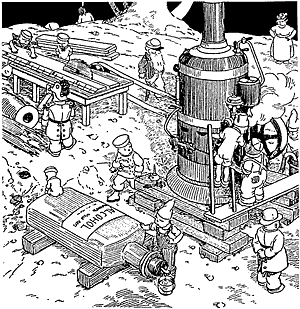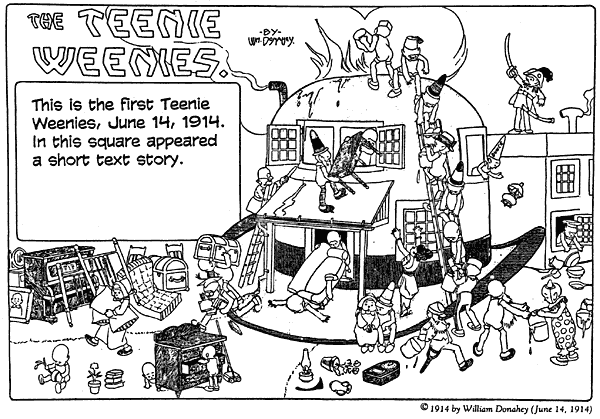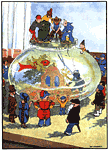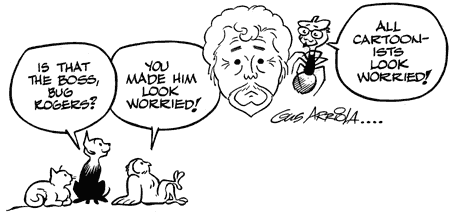 Again
with the Vu Deja on Li’l Folks. “His ‘little folks’ were the oldest
in the country drawn by the same artist . . . then he announced his retirement
. . . he scheduled his finale for publication in February . . . he passed
away on the eve of the publication of the finale . . . however, his beloved
characters will never age and never die.”
Again
with the Vu Deja on Li’l Folks. “His ‘little folks’ were the oldest
in the country drawn by the same artist . . . then he announced his retirement
. . . he scheduled his finale for publication in February . . . he passed
away on the eve of the publication of the finale . . . however, his beloved
characters will never age and never die.”
I’m quoting, here, from a missive sent to
me by attentive reader (and esteemed amigo) Don Petterson, a proud Vermonter.
He is writing about William Donahey and the Teenie Weenies, which
ran from 1914 until 1970, a total of 56 years.
Whoa, deja vu, eh? And we thought Charles
Schulz on Peanuts was the single-handed longevity champion on a
comic strip. And we thought his departure from this vale was unique,
coming as it did on the eve of the last appearance of his life’s work.
So what about the Teenie Weenies?
The Teenie Weenies was not the first
comics feature that Captain Joseph Patterson added to the line-up in the
Sunday funnies of the Chicago Tribune when he came to power in
1912, but it was almost first. (The first was Rudolph Dirks’ Hans
and Fritz, his reincarnation of his famed Katzenjammer Kids--Patterson’s
favorite comic strip.)
As he inspected the content of the Sunday
Trib, Patterson realized he needed a feature for young readers, and
while in that frame of mind, he chanced upon a full color children’s page
in the Cleveland Plain Dealer. The page was filled with Mother
Goose characters and modernized verses and was drawn by William Donahey,
brother of the paper’s editorial cartoonist, James. Patterson promptly
invited William to develop a Sunday page for the Tribune.
Donahey conjured up the Teenie Weenies,
tiny people slightly smaller than the average salt shaker who lived somewhere
on the edge of modern life in a woodland environment. But they almost
didn’t make it into the Tribune.
Patterson was away when Donahey turned in
the first three installments of the feature, and the editor who looked
at them thought that “these stink!” (in his expression). He declined
to publish them. But Donahey waited until Patterson returned, and when
Patterson saw Donahey’s work, he approved their publication.
They first appeared on June 14, 1914, in
black-and-white. It was immediately popular, and Patterson directed that
it appear henceforth in color. It did.
 |
 |
Although
the Teenie Weenies took comic strip form briefly in the 1920s,
it was initially (and for most of its run) a single large drawing with
accompanying narrative text--a weekly short story with an illustration.
Typically, the drawing depicted a swarm of Teenie Weenies engaged in some
project or meeting a crisis while the text gave the narrative details.
This went on for over half a century.
Then in November 1969, Donahey announced
that he was retiring and prepared the last Sunday installment of his feature
for publication on February 2, 1970. Ironically, he died on February
1, the night before its publication.
While the feature’s run embraced 56 years,
the run was actually interrupted twice (1924-33 and 1934-41), dropping
Donahey’s total to 40 years. And those were not consecutive years. Obviously.
And, of course, it was only a Sunday feature.
Who’s the champion for seven-day strippery--for unassisted consecutive
longevity? Still Schulz, of course. But a strong candidate for second
place is Gus Arriola, whose run on Gordo was, at the very least,
38 consecutive years on the daily and Sunday without an assistant. And
that’s the criteria, tovarich--unassisted continuous (unbroken) work on
a seven-day comic strip.
Retailing the humorous adventures and amorous
preoccupations of a portly Mexican bean farmer (“gordo” means “fat”),
his perspicacious nephew, the menagerie of their farm animals and the
other picturesque citizens of their village, Gordo started in the
fall of 1941 and ended in the winter of 1985, almost 44 years.
But the actual continuity of the run was
interrupted for six months when Arriola joined the Army in October 1942.
Assigned to an animation unit which left most of his evenings and weekends
free, Arriola was able to resume doing the strip as a Sunday-only feature
in May 1943; and he reinstated the daily in June 1946. And he had an
assistant for about a year. If you add in the year Arriola did the strip
before going into the army during World War II, you get 39 years solo
on a daily comic strip But for consecutive years on a seven-day strip,
we start with 1947, which yields Arriola’s 38-year run.
I just happen to know all this because (1)
Gordo was my favorite comic strip as a youth and (2) I’m just finishing
a book about Arriola and his creation. About which, more later when I’m
in the shameless plug mode.

send e-mail to R.C. Harvey
art of the comic book - art of the funnies - reviews - order form - rants & raves - Harv's Hindsights - return to main page